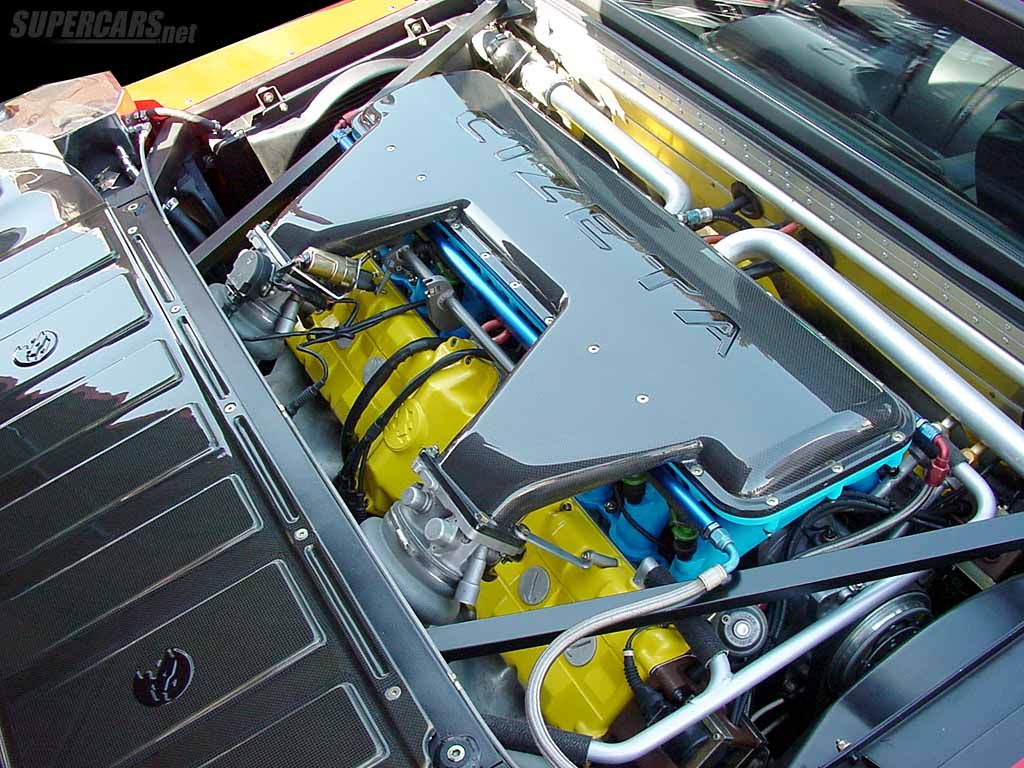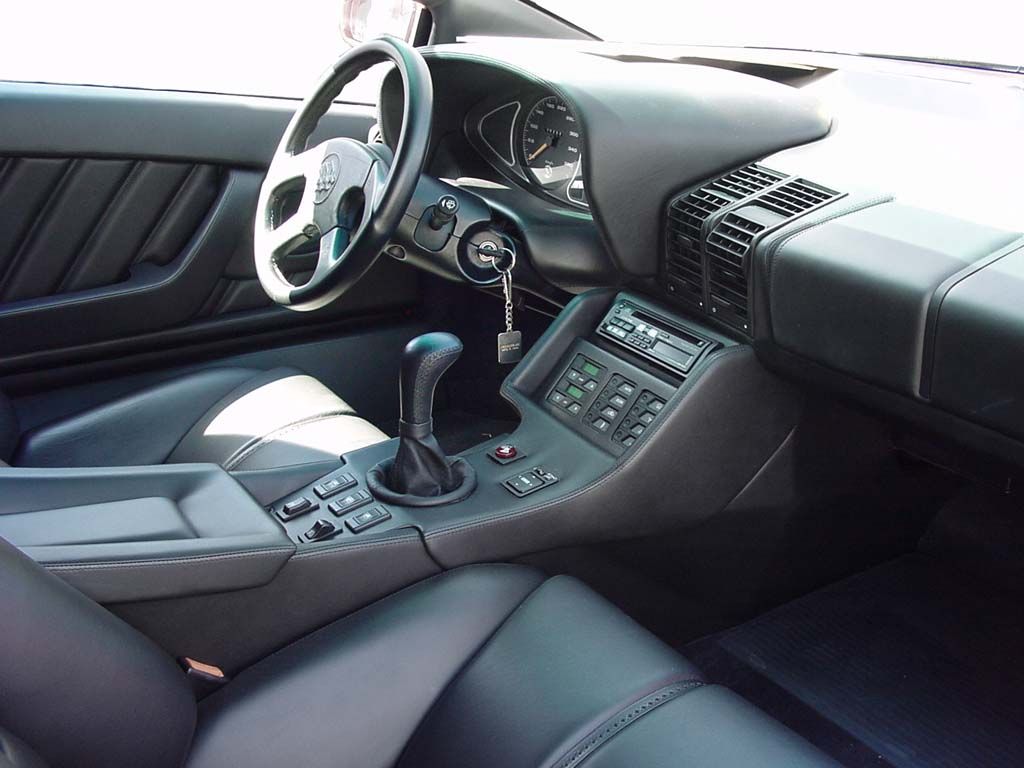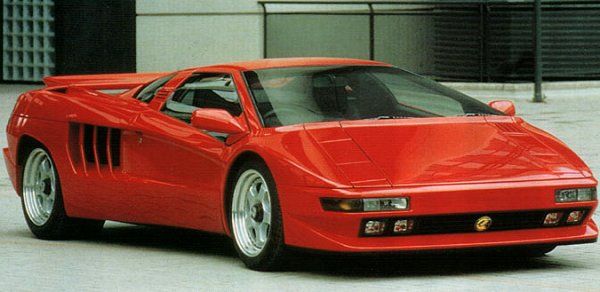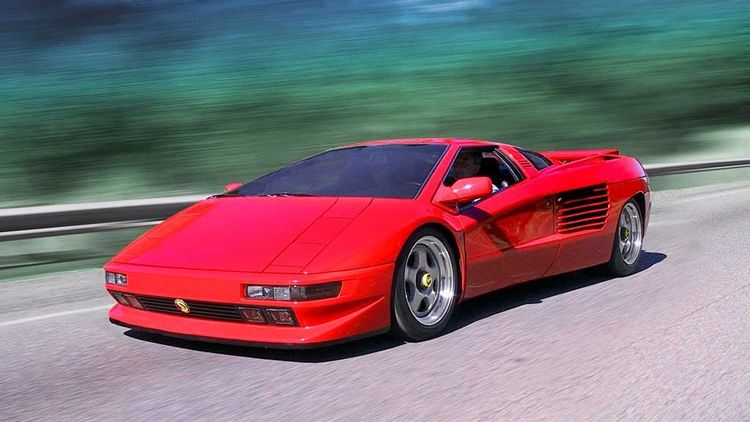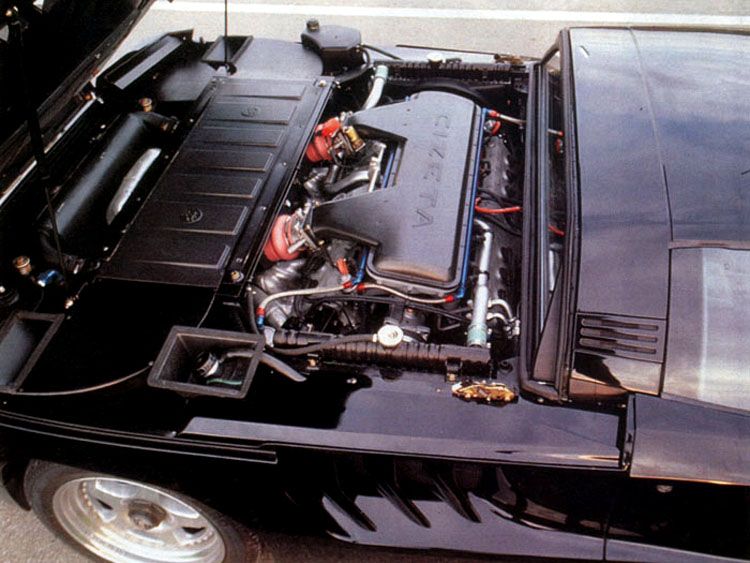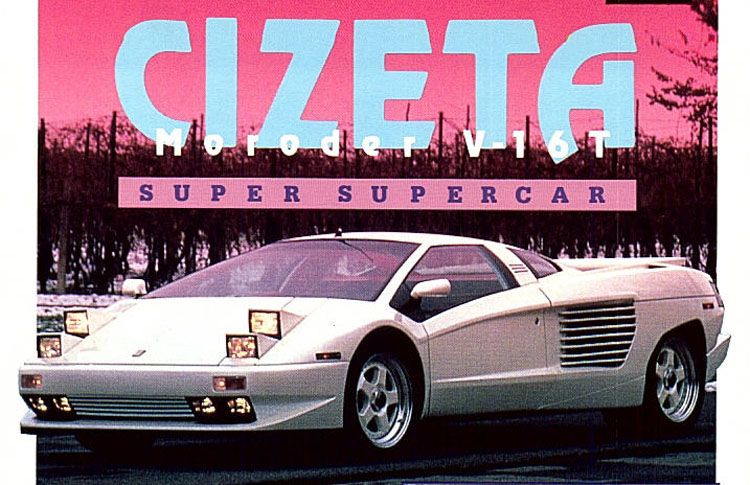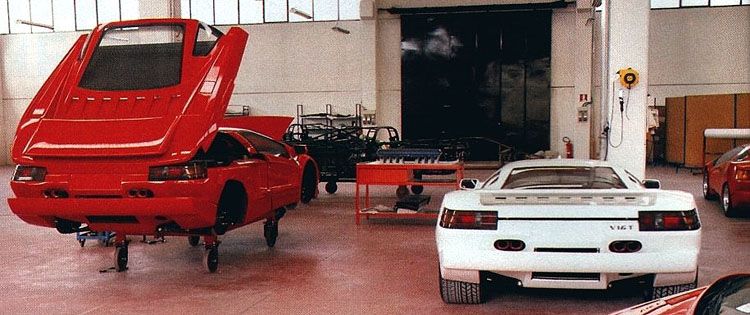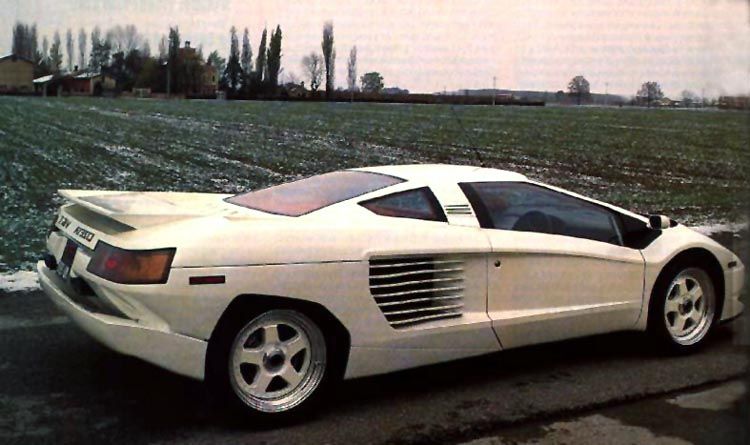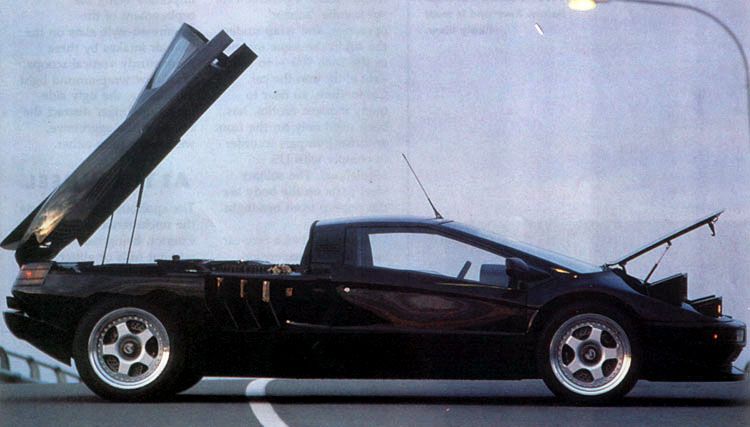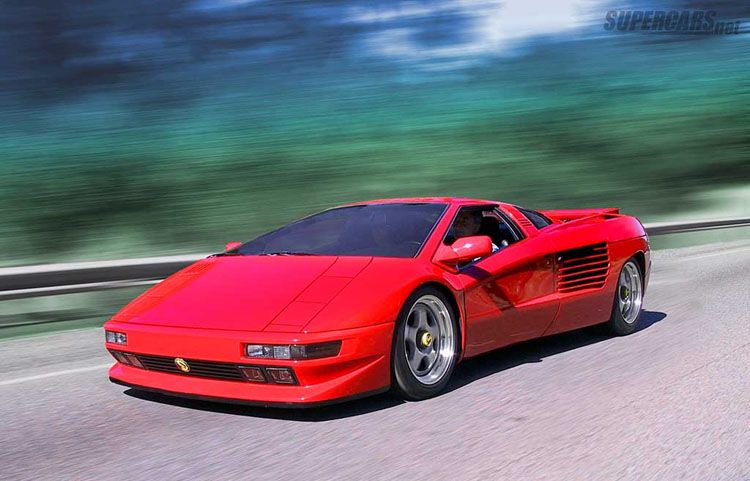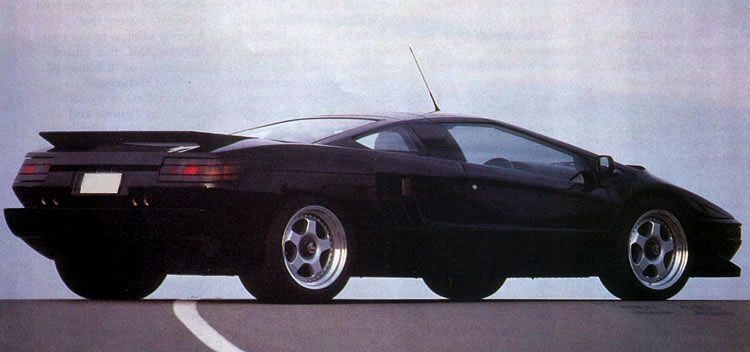The 1980s was a great era for exotic cars. Ferrari->ke252 had the bold Testarossa->ke2391 and the turbocharged F40,->ke434 Porsche->ke1 launched the innovative 959,->ke926 and Lamborghini->ke44 was still improving the Countach->ke387 while also working on the Diablo,->ke376 which arrived in 1990. Bugatti,->ke16 a name that had disappeared in the early 1960s, returned to the market after Italian entrepreneur Romano Arioli acquired the brand in 1987. Claudio Zampolli was another Italian that that entered the supercar->ke177 business in the 1980s. An ex-Ferrari dealer, Zampolli teamed up with Giorgio Moroder, a music producer often credited with pioneering synth disco and electronic music, and established Cizeta Automobili.
The Cizeta-Moroder V16T was the company's only product and, despite its short-lived presence on the market and limited production run, it created quite a stir due to its controversial design and massive V-16 engine.
Set up in the late 1980s, Cizeta->ke23 launched the V16T in 1991. By the time the supercar hit the market, Giorgio Moroder had already left the company, keeping the original prototype and the only V16T to wear both the Cizeta and Moroder names. The controversial design and expensive price tag of the V16T forced Cizeta into bankruptcy, and production of its only supercar ended in 1995. Shortly after Cizeta went under in Italy, Zampolli moved to the U.S. and established Cizeta Automobili U.S.A. in California. He continued building the V16T on demand while also servicing exotic cars.
It's been nearly three decades since the V16T prototype made it's public debut and we decided to have a closer look at this wild-looking supercar. Keep reading to find out what makes it special.
Continue reading to learn more about the 1988 Cizeta Moroder V16T.
1991 Cizeta-Moroder V16T
- Make: Array
- Model: 1991 Cizeta-Moroder V16T
- Engine/Motor: V16
- Horsepower: 560 @ 8000
- Torque: 398 @ 6000
- [do not use] Vehicle Model: Array
Exterior
The 1980s brought many wild-looking supercars, but none was as intriguing as the V16T. The design of the Cizeta-Moroder is actually the most interesting part of the story. The car was penned by Marcello Gandini, who designed the Lamborghini Diablo prior to joining Cizeta. The similarities between the two aren't surprising, as Gandini used the original styling of the Diablo to create the V16T.
Development of the Diablo began in 1985, when the design of the car was contracted to Gandini, who also penned its predecessors, the Countach and the Miura. Gandini submitted a more radical initial design that featured a longer rear section and his signature notched rear-wheel arches, but Chrysler, who had bought Lamborghini in 1987, took the concept to its Detroit-based design team, which altered it heavily. Disappointed with the softer shape of the production Diablo, Gandini took his original sketches to Cizeta.
As a result, the car was considered what the Diablo would have looked like had Chrysler not intervened. However, Gandini's design was slightly altered by Zampolli as well, especially the rear section.
All told, the Cizeta was a more radical interpretation of the Diablo, featuring significantly wider fenders with horizontal strakes (similar to those seen on the Testarossa), a canopy-like roof and glasshouse, and a more aggressive front section. The headlamps were among its most exotic features. Pop-up headlights were quite popular in the 1980s and many sports car manufacturers used them until the 1990s, but Citeza took things further and equipped the V16T with not two, but four of them. Two were positioned just above the nose, where most vehicles had them back in the day, while the other two were mounted behind the first pair, just a few inches below the windshield.
Around back, Cizeta went with rectangular taillights that extended toward rear haunches and a spoiler-like wing atop the engine hood. These solutions were opposed to what most supercar makers used in the 1980s. For instance, the Lamborghini Diablo and the Ferrari F40 had larger, fixed wings and round taillights.
The Cizeta was definitely wild to look at, but at the same its design was of the "love it or hate it" variety. On the other hand, the fact that the Diablo is a lot more popular is due to the fact that Cizeta-Moroder was a new company and the V16T didn't benefit from the marketing campaign that backed the Lambo.
Exterior Dimensions
|
Wheelbase |
2,690 MM (105.90 Inches) |
|
Overall length |
4,440 MM (174.80 Inches) |
|
Overall width |
2,050 MM (80.70 Inches) |
|
Overall height |
1,120 MM (44.09 Inches) |
|
Track front |
1,610 MM (63.38 Inches) |
|
Track Rear |
1,670 MM (65.74 Inches) |
|
Weight |
1,600 KG (3,527 LBS) |
Interior
Most supercars of the era had simple interiors with far fewer gadgets than modern vehicles. The V16T was no exception to that rule, but it looked quite spartan when compared to a 1980s Lamborghini or Ferrari. The reason for that was that Zampolli was a big fan of race cars and classic Ferraris. More importantly, he did not believe in gauges and fancy indicators. In his own words: "People don't look at gauges. So I decided to make things compact and simple with everything in front of you like a racing car."
One quick glance at the interior is enough to notice the simplicity of the V16T's cockpit. The instrument cluster consisted of only two gauges, a tach and a speedometer. The dashboard was as basic as possible, while the center console had a few buttons just above the center console. The latter contained a few more switches and the sporty, fat gear shifter. But, despite its simplicity, the cockpit was plush and comfortable for a supercar. The seats and the door panels were wrapped in leather, while the floor was covered in soft mats.
The V16T was offered with many upholstery colors, including red, bright-blue, cream, and black. Also, customers had the options to go with two-tone interiors that matched those offered by Ferrari and Lamborghini in the late 1980s.
Drivetrain
Named after its drivetrain, the V16T used a 90-degree, transverse V-16 powerplant. The 6.0-liter unit was made from two flat-plane V-8s sourced from the Lamborghini Urraco and assembled together in such way that the timing mechanisms shared the center space. The block was cast a fully custom piece instead of two V-8 blocks "glued" together. The massive engine mated to a ZF-built five-speed manual transmission. The gearbox was longitudinal and, together with the engine, formed the shape of a T -- a concept Gandini originally created for the Lamborghini Miura. The Cizeta V16T was the first and only production vehicle to feature a V-16 unit mounted in a transverse layout. The setup was necessary due to the length of the engine and made the V16T's rear section impressively wide.
The massive V-16 sent 540 horsepower and 400 pound-feet of torque to the rear wheels. The sprint from 0 to 60 mph took only 4.4 seconds, which made it a tenth-second quicker than the standard Lamborghini Diablo and a half-second faster than the Ferrari F512 TR. Its top speed was estimated at 204 mph, which was identical to the Diablo's -- the first Lamborghini to blow past the 200-mph mark.
Everything was mounted on an aluminum and tubular steel spaceframe. The suspension system consisted of unequal wishbones with coil sprints and inboard Koni dampers in the front and rear. Stopping power was provided by vented Brembo discs with vacuum assist and four-pot calipers. The tires were wrapped in Pirelli P-Zero rubber for optimum traction under full throttle.
Drivetrain Specifications
|
Type |
V-16 90 degree, transversely mid mounted, rear wheel drive |
|
Distribution |
Dual overhead camshafts, chain drive, four valves/cylinder |
|
Cyl. Capacity |
5995 cc |
|
Bore & stroke |
86 x 64.5 mm |
|
Compr. ratio |
9.3:1 |
|
Max. power |
560 HP @ 8,000 RPM |
|
Max. torque |
398 LB-FT @ 6,000 RPM |
|
Top speed |
328 KM/H (204 MPH) |
|
0 - 100 KM/H (62 MPH) |
4.4 seconds |
Prices
In 1991, the list price for a Cizeta-Moroder was €250,000 or $300,000. For reference, this was significantly more than a Diablo, which was priced from $239,000 in 1990. The Ferrari 512 TR, for instance, was sold for around $200,000 before options in 1991. Although Cizeta's initial predictions foresaw one car per week, only 19 examples, including the prototype, were actually built from 1991 until 1995, when the company went bankrupt. Three more cars were completed between 1999 and 2003, including a custom spyder version. When Zampolli moved to America and established Cizeta Automobili U.S.A., production of the V16T was restarted on a made to order basis. In 2006, the V16T was priced from a whopping $649,000.
Cizeta V16Ts from the initial production batch rarely show up on the used car market, and estimating their value is next to impossible. Their scarcity is not surprising given that a little more than 20 were built, not including the continuation models assembled in the U.S. The fact that the V16 is illegal to drive or to even own in the United States, because it does not meet emissions and safety standards, may have something to do with the fact that they rarely show up in North America. A V16T worth $700,000 was seized by United States Immigration and Customs Enforcement on December 7, 2009 after its owner violated multiple U.S. import laws.
Competition
Lamborghini Diablo
A proper mass-produced supercar built by a famous carmaker, the Diablo isn't the type of car I'd usually compare to the V16T, but the design similarities between the two sparked a lot of debate back in the early 1990s.
A major departure in terms of styling and power compared to the Countach, the Diablo was launched in 1990 and received various drivetrain configurations until production ended in 2001. While all models were powered by the same 5.7-liter V-12 until 1999, output ranged between 492 and 523 horsepower. The least powerful model came with 492 horses and 428 pound-feet of torque, 48 horsepower less but 28 pound-feet more than the Cizeta. The base Diablo was a bit slower, needing 4.5 seconds to hit 60 mph. The lighter VT was as quick as the V16T but all the rest, including the SE and SV, were up to a half-second quicker. The Diablo was priced from $239,000 in 1991.
Find out more about the Lamborghini Diablo here.
Vector W8
Much like the V16T, the W8 was built by a small venture with no heritage whatsoever. Vector was founded in 1971 in Wilmington, California. The W8 arrived in 1989 with a sharp and unique appearance that wowed the crowds, and an interior that was considered state-of-the-art in the early 1990s. Motivation came from a 6.0-liter V-8 that started life as a 5.7-liter Chevy. With two Garrett turbochargers attached to it, the V-8 sent 650 horsepower and 649 pound-feet of torque to the pavement through an Oldsmobile-sourced, three-speed automatic transmission and a Gleason-Torsen differential. Charging from 0 to 60 mph took 4.2 seconds, while top speed was estimated at 218 mph. In 1992, it was declared the fastest production car in the world by Road & Track, but its laurels were quickly stolen by the McLaren F1, which was launched only months later. The W8 is considered the first American-built supercar. Only 19 were produced, 17 of which were customer cars. The W8 was significantly more expensive than the V16T, retailing from nearly $400,000 in 1990.
Read more about the Vector W8 here.
Conclusion
Granted, the Cizeta V16T was far from successful and, despite all the hype it generated at launch, the whole project is often regarded as a big flop. There are many reasons why the V16T didn't catch on. Its design was a bit too wild, while its $300,000 was far from tempting with Lamborghini and Ferrari asking less than $250,000 for their V-12-powered supercars. However, I think that the V16T deserves a place in the automotive hall of fame for its bold and no-nonsense styling and oddball V-16 transverse drivetrain. If anything, this car should be appreciated for the fact that Cizeta had the guts to use the Marcello Gandini design that Lamborghini discarded. The V16T is part of an exclusive group of supercars that are worth more to the automotive industry than given credit for. This exclusive list also includes the Vector W8, Jaguar XJ220, and [DeTomaso Pantera.
->ke1296]


